ERQ:32位转5位仅掉些许精度,来看看两段式后训练量化 | ICML 2024
后训练量化(
PTQ)在视觉Transformer(ViTs)领域引起了广泛关注,因为它在模型压缩方面表现出了高效率。然而,现有的方法通常忽视了量化权重和激活之间复杂的相互依赖关系,导致了相当大的量化误差。论文提出了一种名为ERQ的两步PTQ方法,精心设计用于顺序降低激活和权重量化带来的量化误差。ERQ首先引入了激活量化误差减小(Aqer),将激活量化误差的最小化策略性地表述为一个岭回归问题,并通过使用全精度更新权重来解决。随后,ERQ引入了权重量化误差减小(Wqer),采用迭代的方法来减轻由权重量化引起的量化误差。在每次迭代中,采用经验推导出的有效代理来细化量化权重的舍入方向,并结合岭回归求解器以减少权重量化误差。实验结果证明了该方法的有效性。值得注意的是,ERQ在W3A4 ViT-S的准确性上超越了最先进的GPTQ,提升幅度达22.36%。来源:晓飞的算法工程笔记 公众号,转载请注明出处
论文: ERQ: Error Reduction for Post-Training Quantization of Vision Transformers

Introduction
视觉Transformer(ViTs)显著挑战了卷积神经网络(CNNs),成为计算机视觉领域的新范式。ViTs利用多头自注意力(MHSA)机制来捕捉图像块之间的长距离关系,在各种视觉任务中展现出令人印象深刻的进展。
然而,强大的能力伴随着相当的复杂性。ViTs固有的架构复杂性导致了高计算需求和可观的内存要求,这在资源受限的环境中部署时带来了挑战。为了缓解这一困境,模型量化吸引了业界和学术界的持续关注。量化通过实现权重和激活的低位表示来减少模型复杂性,为高效部署提供了一条有前景的途径。最近,研究人员逐渐关注于视觉Transformer的后训练量化(PTQ),该方法旨在利用一个小型校准数据集和较低的成本对模型进行量化。
为了适应ViTs独特的结构,已经许多研究探索了各种后训练量化(PTQ)方法。例如,为了处理长尾post-Softmax激活,有研究提出了 \(log2/log \sqrt{2}\) 量化器和twin uniform量化器。为了管理高度变化的激活,有研究采用了重参数化技术和power-of-two因子。此外,有研究采用进化搜索方法来确定不稳定的缩放因子。然而,现有的方法通常忽视了权重和激活量化之间复杂的相互依赖关系,这在权重-激活量化时导致了相当大的量化误差。
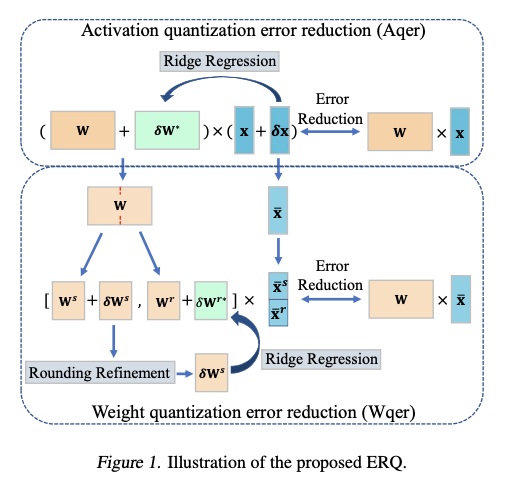
论文提出一种为ViTs量身定制的两步后训练量化方法ERQ,旨在顺序减小由量化激活和权重引起的量化误差。如图1所示,ERQ由两个步骤组成,即激活量化误差减少(Aqer)和权重量化误差减少(Wqer)。Aqer将激活量化引起的量化误差公式化为一个岭回归问题,该问题可以通过权重更新以闭式解的方式解决。随后,引入Wqer以迭代的量化和修正方式减小由权重量化引起的量化误差。特别地,在每次迭代中,量化全精度权重的前半部分,并通过先执行四舍五入细化,后再次解决岭回归问题来减小产生的量化误差。前者推导出输出误差的有效代理,用于细化量化权重的四舍五入方向,以降低量化误差。后者则通过更新剩余的全精度权重进一步减小量化误差。这样的过程持续进行,直到所有权重被准确量化。
ERQ在对各种ViTs变体(ViT、DeiT和Swin)及任务(图像分类、目标检测和实例分割)进行的广泛实验中证明了其有效性。值得注意的是,在图像分类任务中,ERQ在W3A4 ViT-S上比GPTQ的性能提高了22.36%。
Method
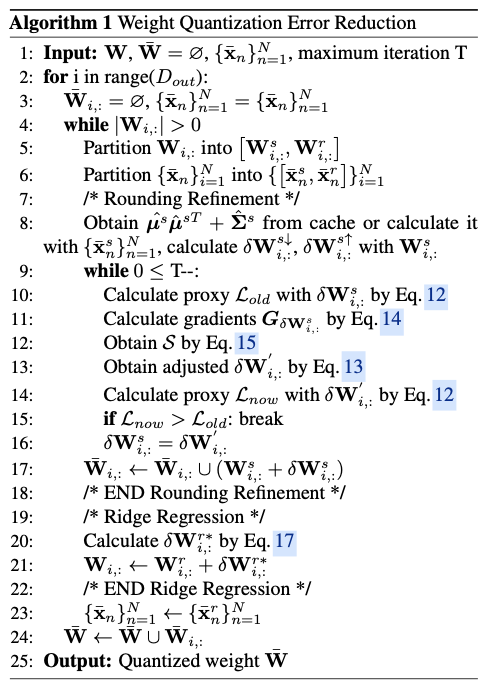
相互纠缠的 \(\delta{\mathbf{x}}\) 和 \(\delta\mathbf{W}\) 使得找到公式 4 的最优解变得具有挑战性。为使问题变得可处理,将公式 4放宽为两个顺序的子问题,通过分别最小化来自量化激活和权重的误差。如图1所示,首先进行激活量化误差减少 (Aqer),然后进行权重量化误差减少 (Wqer)。
Activation Quantization Error Reduction
为减轻由激活量化引起的误差,引入激活量化误差减少 (Aqer),将误差减轻问题形式化为岭回归问题。具体来说,将权重保留为全精度,仅考虑由激活量化误差 \(\delta{\mathbf{x}}\) 引起的均方误差 (MSE):
为了最小化公式 5,将其形式化为岭回归问题,其中通过将权重 \(\mathbf{W}\) 与调整项 \(\delta\mathbf{W}^*\) 相加来完成最小化:
这里, \(\delta\mathbf{W}^*\) 表示通过岭回归计算出的调整项, \(\bar{\mathbf{x}}=\mathbf{x}+\delta\mathbf{x}\) 是量化输入, \(\lambda_1\| \delta\mathbf{W}^* \|_2^2\) 作为正则化项, \(\lambda_1\) 是控制正则化强度的超参数。公式6构成了岭回归问题。为了最小化它,首先计算其相对于 \(\delta\mathbf{W}^*\) 的梯度:
然后,通过将公式 7设置为零来求解 \(\delta\mathbf{W}^*\) :
正则化项 \(\lambda_1 \mathbf{I}\) 确保 \(\mathbb{E} \left[\bar{\mathbf{x}}\bar{\mathbf{x}}^T \right] + \lambda_1 \mathbf{I}\) 的逆始终存在,这对计算稳定性至关重要。此外,它抑制了异常值,从而减轻了过拟合,提高了模型的泛化能力。抑制异常值对于随后的权重量化也至关重要,因为它限制了权重的范围。这种限制防止量化点分布在未覆盖的区域,从而增强了量化的表达能力。
在实践中,给定校准数据集,使用 \(\frac{1}{N}\sum_n^N \delta{\mathbf{x}}_n\bar{\mathbf{x}}_n^T\) 和 \(\frac{1}{N}\sum_n^N \bar{\mathbf{x}}_n\bar{\mathbf{x}}_n^T\) 分别估计 \(\mathbb{E}\left[\delta{\mathbf{x}}\bar{\mathbf{x}}^T\right]\) 和 \(\mathbb{E}\left[\bar{\mathbf{x}}\bar{\mathbf{x}}^T \right]\) 。这里, \(N = B\times T >> D_{in}^s\) ,其中 \(B\) 是校准数据集的大小, \(T\) 是一张图像的标记数量。请注意, \(\delta{\mathbf{x}}\) 和 \(\bar{\mathbf{x}}\) 是在给定输入和量化参数的情况下确定的。在得到 \(\delta\mathbf{W}^*\) 后,通过 \(\mathbf{W} = \mathbf{W} + \delta\mathbf{W}^*\) 将其合并到网络的权重中。通过这样做,所提出的Aqer明确减轻了从量化激活到权重的量化误差。
Weight Quantization Error Reduction
在进行Aqer后需执行权重量化,提出权重量化误差减少(Wqer)来减轻由此产生的量化误差。在这里,目标被定义为:
注意,在进行Aqer后,激活值被量化。公式9表明输出通道之间的最小化是独立进行的。因此,分别分析每个 \(\mathcal{L}^{\text{MSE}}_i\) 的最小化。同时对整个全精度权重进行量化会导致无法恢复的量化误差。因此,采用迭代的量化和修正方法,逐步减少由权重量化引起的量化误差。
在每次迭代中,首先对未量化权重的前半部分进行量化,然后减轻由此产生的量化误差。具体来说,从当前的全精度权重 \(\mathbf{W}_{i,:}\) 和相应的 \(\bar{\mathbf{x}}\) 开始。然后,将 \(\mathbf{W}\) 划分为两个部分:前半部分 \(\mathbf{W}^s_{i,:} \in \mathbb{R}^{ 1\times D_{in}^s}\) 用于量化,而剩余部分 \(\mathbf{W}^r_{i,:} \in \mathbb{R}^{1 \times D_{in}^r}\) 保持全精度。对应地,从 \(\bar{\mathbf{x}}\) 中派生出 \(\bar{\mathbf{x}}^s \in \mathbb{R}^{D_{in}^s}\) 和 \(\bar{\mathbf{x}}^r \in \mathbb{R}^{D_{in}^r}\) ,其中 \(\bar{\mathbf{x}}^s\) 和 \(\bar{\mathbf{x}}^r\) 分别包含与 \(\mathbf{W}^s_{i,:}\) 和 \(\mathbf{W}^r_{i,:}\) 对应的 \(\bar{\mathbf{x}}\) 的行。量化后的 \(\mathbf{W}^s_{i,:}\) 的量化误差记为 \(\delta\mathbf{W}^s_{i,:} = \bar{\mathbf{W}}^s_{i,:} - \mathbf{W}^s_{i,:}\) ,由此产生的均方误差(MSE)为:
在这里, \(\mathbf{W}_{i,:} = [ \mathbf{W}^s_{i,:},\mathbf{W}^r_{i,:} ]\) , \(\bar{\mathbf{x}} = [ \bar{\mathbf{x}}^s, \bar{\mathbf{x}}^r ]\) 。为了减轻公式10,首先引入四舍五入优化(Rounding Refinement),在该过程中会细化量化权重的四舍五入方向。比如调整 \(\delta\mathbf{W}^s_{i,:}\) ,以减少 \(\mathbb{E} \left[ \| \delta\mathbf{W}^s_{i,:}\bar{\mathbf{x}}^s \|_2^2 \right]\) 本身。然后,在四舍五入优化之后,给定 \(\mathbb{E} \left[ \| \delta\mathbf{W}^s_{i,:}\bar{\mathbf{x}}^s \|_2^2 \right]\) ,构建一个岭回归(Ridge Regression)问题,通过调整 \(\mathbf{W}^r_{i, :}\) 来进一步减轻该误差。
Rounding Refinement
最初,目标是调整量化权重的四舍五入方向,以最小化 \(\mathbb{E} \left[ \| \delta\mathbf{W}^s_{i,:}\bar{\mathbf{x}}^s \|_2^2 \right]\) 。具体来说,对于 \(\mathbf{W}^s_{i,:}\) 中的第 \(j\) 个值,记作 \(\mathbf{W}^s_{i,j}\) ,量化过程涉及向下取整或向上取整。因此, \(\mathbf{W}^s_{i,:}\) 的量化误差,记作 \(\delta\mathbf{W}^s_{i,j}\) ,可以表示为 \(\delta\mathbf{W}^{s\downarrow}{i, j}\) 或 \(\delta\mathbf{W}^{s\uparrow}{i, j}\) 。这里, \(\delta\mathbf{W}^{s\downarrow}_{i, j} = \mathbf{W}^s_{i,j} - \text{Q}_{un\downarrow}(\mathbf{W}^s_{i,j}, b) > 0\) 表示采用向下取整策略所产生的误差, \(\delta\mathbf{W}^{s\uparrow}_{i, j} = \mathbf{W}^s_{i,j} - \text{Q}_{un\uparrow}(\mathbf{W}^s_{i,j}, b) < 0\) 表示采用向上取整策略所产生的误差,其中 \(\downarrow/\uparrow\) 表示在公式1中将 \(\left\lfloor \cdot \right\rceil\) 替换为 \(\left\lfloor \cdot \right\rfloor\) / \(\left\lceil \cdot \right\rceil\) 。

选择 \(\delta\mathbf{W}^s_{i,:}\) 是一个NP难题,其解可以通过混合整数二次规划(MIPQ)进行搜索。然而, \(\mathbb{E} \left[ \| \delta\mathbf{W}^s_{i,:}\bar{\mathbf{x}}^s \|_2^2 \right]\) 的高计算复杂度使得在合理时间内找到解决方案成为一项挑战。如表1所示,使用 \(\mathbb{E} \left[ \| \delta\mathbf{W}^s_{i,:}\bar{\mathbf{x}}^s \|_2^2 \right]\) 作为MIPQ的目标消耗了约130小时的巨大时间成本。
-
Efficient Proxy
因此,目标是找到 \(\mathbb{E} \left[ \| \delta\mathbf{W}^s_{i,:}\bar{\mathbf{x}}^s \|_2^2 \right]\) 的一个高效代理。首先,将 \(\mathbb{E} \left[ \| \delta\mathbf{W}^s_{i,:}\bar{\mathbf{x}}^s \|_2^2 \right]\) 重写为:
这里, \(\Delta\) 表示利用 \(\mathbb{E}\left[ Z^2 \right] = (\mathbb{E}\left[ Z \right])^2 + \text{Var}\left[ Z \right]\) 。

根据中心极限定理,神经网络中的大量乘法和加法运算使得激活值通常呈现出高斯分布,这也是许多以前量化领域研究的基本假设。同时,图2展示了全精度和量化激活的通道分布。可以看出,量化激活仍然表现出近似的高斯分布。
因此,论文认为 \(\bar{\mathbf{x}}^s\) 的通道分布仍然可以通过高斯分布进行捕捉,并用 \(D_{in}^s\) 维的高斯分布 \(\mathcal{N}(\boldsymbol{\mu}^s, \boldsymbol{\Sigma}^s)\) 对 \(\bar{\mathbf{x}}^s\) 进行建模,其中 \(D_{in}^s\) 是 \(\bar{\mathbf{x}}^s\) 的维度, \(\boldsymbol{\mu}^s \in \mathbb{R}^{D_{in}^s}, \boldsymbol{\Sigma}^s \in \mathbb{R}^{D_{in}^s \times D_{in}^s}\) 。然后,公式11变为:
这里,公式12是得到的 \(\mathbb{E} \left[ \| \delta\mathbf{W}^s_{i,:}\bar{\mathbf{x}}^s \|_2^2 \right]\) 的代理。在实践中,使用给定的校准数据集来估计经验值 \(\hat{\boldsymbol{\mu}}^s\) 和 \(\hat{\boldsymbol{\Sigma}}^s\) 。请注意,对于所有输出通道, \(\hat{\boldsymbol{\mu}}^s\) 和 \(\hat{\boldsymbol{\Sigma}}^s\) 是共享的,只需进行一次计算。
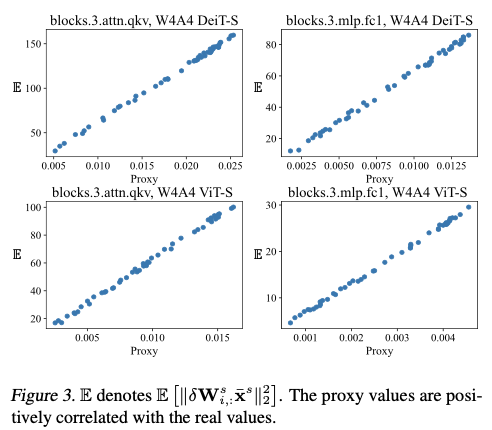
图3展示了代理与 \(\mathbb{E} \left[ \| \delta\mathbf{W}^s_{i,:}\bar{\mathbf{x}}^s \|_2^2 \right]\) 之间的关系。可以看出,所提出的代理与真实值成比例,证明了其可信度。
使用代理的计算复杂度为 \(O((D_{in}^s)^2)\) ,而 \(\mathbb{E} \left[ \| \delta\mathbf{W}^s_{i,:}\bar{\mathbf{x}}^s \|_2^2 \right]\) 的复杂度为 \(O(ND_{in}^s)\) ,其中 \(N >> D_{in}^s\) 。因此,该代理可以作为一个低成本的目标,用于求解 \(\delta\mathbf{W}^s_{i,:}\) 。如表1所示,将方程12作为MIPQ的目标将时间成本从约130小时降低到约10小时。然而,由于当前开源的MIPQ实现仅支持CPU,无法充分利用GPU的能力,这样的成本仍然是适度的。接下来将介绍Rounding Refinement,一种支持GPU的方法,利用代理的梯度更快地调整 \(\delta\mathbf{W}^s_{i,:}\) 。
-
Rounding Refinement
首先,使用最接近取整策略初始化 \(\delta\mathbf{W}^s_{i,j}\) 。此时, \(\delta\mathbf{W}^s_{i,j}\) 要么等于 \(\delta\mathbf{W}^{s\downarrow}_{i, j}\) ,要么等于 \(\delta\mathbf{W}^{s\uparrow}_{i, j}\) 。然后,目标是确定一个索引集合 \(\mathcal{S}\) ,该集合包含需要修改的元素的索引集合,其取整方向被颠倒:
为了确定 \(\mathcal{S}\) ,首先对代理(公式12)相对于 \(\delta\mathbf{W}^s_{i,:}\) 求导。
只选择梯度符号相同的元素,因为这才是允许颠倒的唯一方式。例如,当 \(\delta\mathbf{W}_{i, j}^s = \delta\mathbf{W}^{s\downarrow}_{i, j}\) 时,仅当 \(\boldsymbol{G}_{\delta\mathbf{W}_{i, j}^s}\) 与 \(\delta\mathbf{W}_{i, j}^s\) 具有相同的符号时,才能将其替换为 \(\delta\mathbf{W}^{s\uparrow}_{i, j}\) 。因此,索引集合 \(\mathcal{S}\) 定义为:
这里, \(\mathrm{topk\_index}\) 返回前 \(\mathrm{k}\) 个元素的索引, \(\mathbb{1}(\cdot)\) 对于非负输入返回1,对负输入返回0, \(\lvert \cdot \rvert\) 返回输入的绝对值。
在获得 \(\mathcal{S}\) 后,通过公式13进行颠倒。上述过程会迭代,直到调整后的 \(\delta\mathbf{W}^s_{i, :}\) 引发更大的代理值或达到最大迭代次数。在获得 \(\delta\mathbf{W}^s_{i, :}\) 后,量化可以通过 \(\bar{\mathbf{W}}^s_{i, :} = \mathbf{W}^s_{i, :}+\delta\mathbf{W}^s_{i, :}\) 完成。然后,将 \(\bar{\mathbf{W}}^s_{i, :}\) 添加到量化权重集合中。Rounding Refinement的整体过程在算法1的第7行到第18行中给出。如表1所示,Rounding Refinement通过 \(150\times\) 的成本显著减少了时间开销,从10小时减少到4分钟,同时可接受的准确性损失。
-
Ridge Regression
在Rounding Refinement之后,建议用 \(\delta\mathbf{W}^{r*}_{i, :}\) 调整 \(\mathbf{W}^r_{i, :}\) ,以进一步抵消 \(\mathbb{E} \left[ \| \delta\mathbf{W}^s_{i,:}\bar{\mathbf{x}}^s \|_2^2 \right]\) ,从而得到以下目标:
其中, \(\lambda_2\) 是一个超参数,用于控制正则化项 \(\lambda_2\| \delta\mathbf{W}^{r*}_{i, :} \|_2^2\) 的强度。公式16的最小化形成了岭回归问题,解决方案定义为:
在实践中,通过使用 \(\frac{1}{N}\sum_n^N \bar{\mathbf{x}}_n^r\bar{\mathbf{x}}_n^{sT}\) 和 \(\frac{1}{N}\sum_n^N \bar{\mathbf{x}}_n^r\bar{\mathbf{x}}_n^{rT}\) 来估计 \(\mathbb{E}\left[\bar{\mathbf{x}}^r \bar{\mathbf{x}}^{sT}\right]\) 和 \(\mathbb{E}\left[\bar{\mathbf{x}}^r \bar{\mathbf{x}}^{rT} \right]\) 。随后, \(\mathbf{W}^r_{i, :} = \mathbf{W}^r_{i, :}+\delta\mathbf{W}^{r*}_{i, :}\) 以减小误差。目前, \(\mathbf{W}^r_{i, :}\) 仍然保持为全精度,并将在下一次迭代中处理。该过程持续进行,直到所有权重被准确量化。所提出的Rounding Refinement和Ridge Regression共同形成了Wqer,其整体过程在算法1中给出。在实践中,对多个输出通道并行执行Wqer。
Experiments
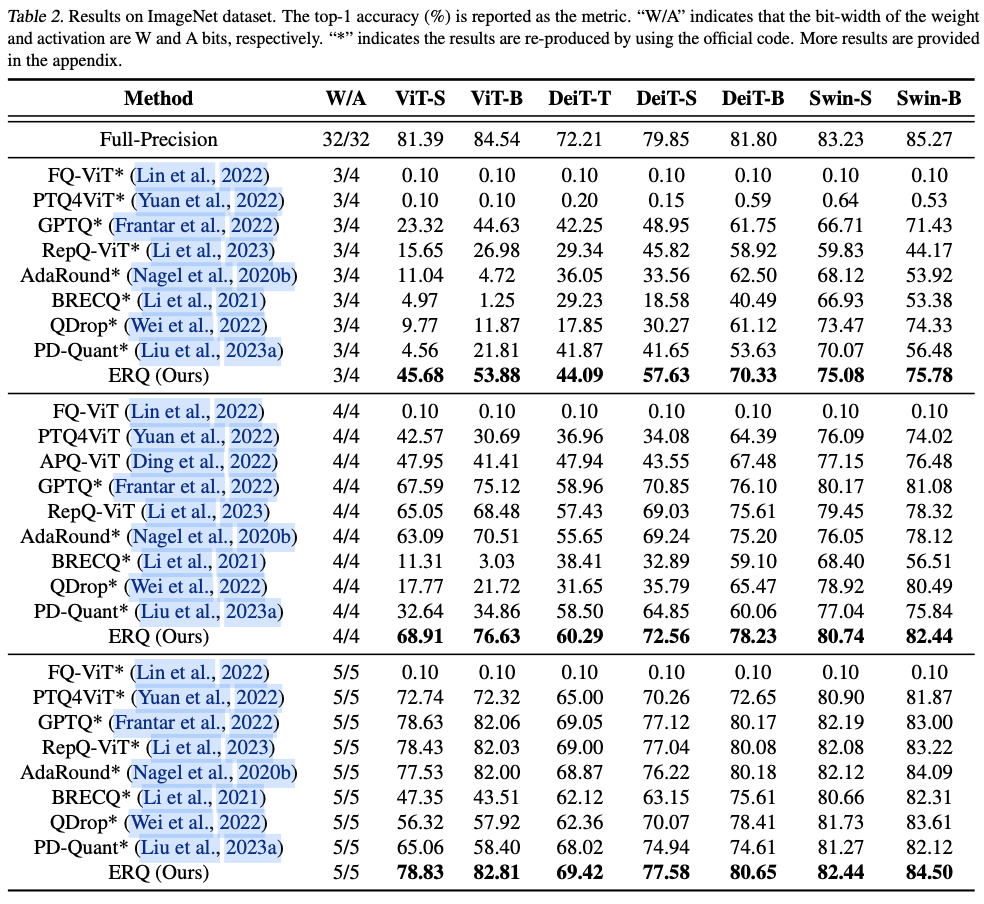
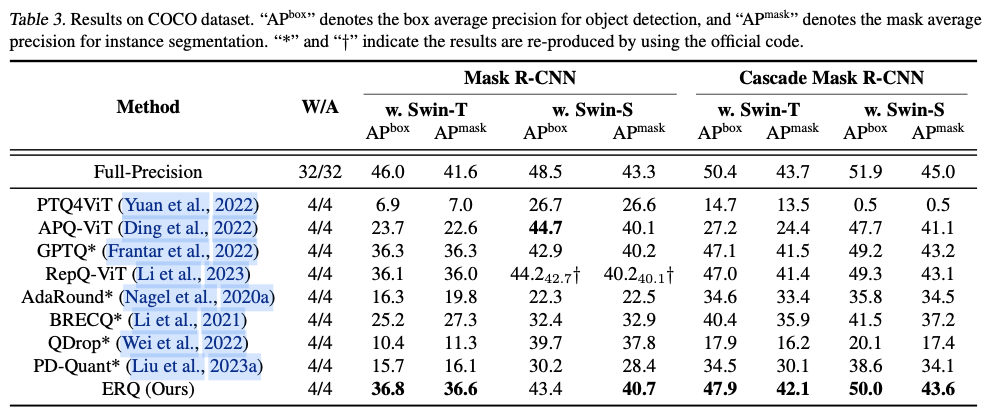
如果本文对你有帮助,麻烦点个赞或在看呗~
更多内容请关注 微信公众号【晓飞的算法工程笔记】





